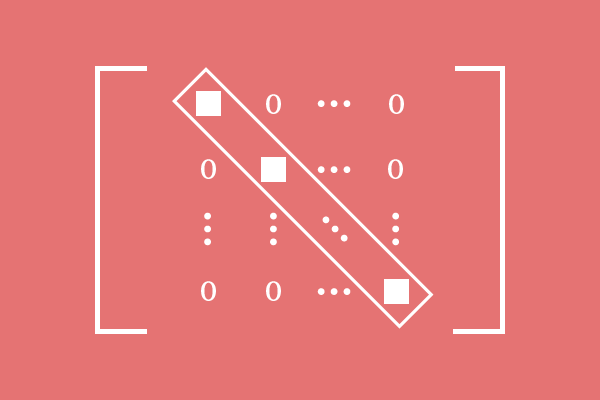A matrix that consists of equal diagonal elements and zeros as non-diagonal entries is called a scalar matrix.
In a special case, each entry in the main diagonal (or leading diagonal) can be equal and the remaining non-diagonal elements can be zeros in the matrix.

The following matrix is an example for this case.
$M$ $\,=\,$
$\begin{bmatrix}
c & 0 & 0 & \cdots & 0\\
0 & c & 0 & \cdots & 0\\
0 & 0 & c & \cdots & 0\\
\vdots & \vdots & \vdots & \ddots & \vdots\\
0 & 0 & & \cdots & c\\
\end{bmatrix}
$
In English language, the word “scalar” is used to express “of a quantity”. Hence, the word “scalar” is added before the word “matrix” for expressing the equality of entries in the matrix.
Therefore, a scalar matrix is a matrix in which the diagonal elements are equal and non-zeros but the non-diagonal elements are zeros.
A scalar matrix is basically a square matrix and also a diagonal matrix due to the equality property of the entries.
$e_{11}$ $\,=\,$ $e_{22}$ $\,=\,$ $e_{33}$ $\,=\,$ $\cdots$ $\,=\,$ $e_{mm}$
When the matrix $M$ is simply written as $\begin{bmatrix} e_{ij}\\ \end{bmatrix}$, there are two conditions for calling a matrix as a scalar matrix.
The below three examples are some best examples for a scalar matrix.
$A$ $\,=\,$
$\begin{bmatrix}
6 & 0 \\
0 & 6 \\
\end{bmatrix}
$
It is a square matrix of the order $2$. In this matrix, the diagonal elements are equal and each diagonal element is $6$, and the remaining elements are zero. Hence, the matrix $A$ is called a scalar matrix.
$B$ $\,=\,$
$\begin{bmatrix}
-1 & 0 & 0\\
0 & -1 & 0\\
0 & 0 & -1\\
\end{bmatrix}
$
The matrix $B$ is a square matrix of the order $3 \times 3$. In this matrix, the diagonal entries are non-zero elements and each entry is $-1$, and the non-diagonal elements are zero. Therefore, the matrix $B$ is an example matrix for a scalar matrix.
$C$ $\,=\,$
$\begin{bmatrix}
2 & 0 & 0 & 0\\
0 & 2 & 0 & 0\\
0 & 0 & 2 & 0\\
0 & 0 & 0 & 2\\
\end{bmatrix}
$
The matrix $C$ is a scalar matrix of the order $4$ because the elements in the main diagonal (or principal diagonal) are non-zeros and each element in the leading diagonal is $2$ but the remaining elements are zero.
A free math education service for students to learn every math concept easily, for teachers to teach mathematics understandably and for mathematicians to share their maths researching projects.
Copyright © 2012 - 2023 Math Doubts, All Rights Reserved